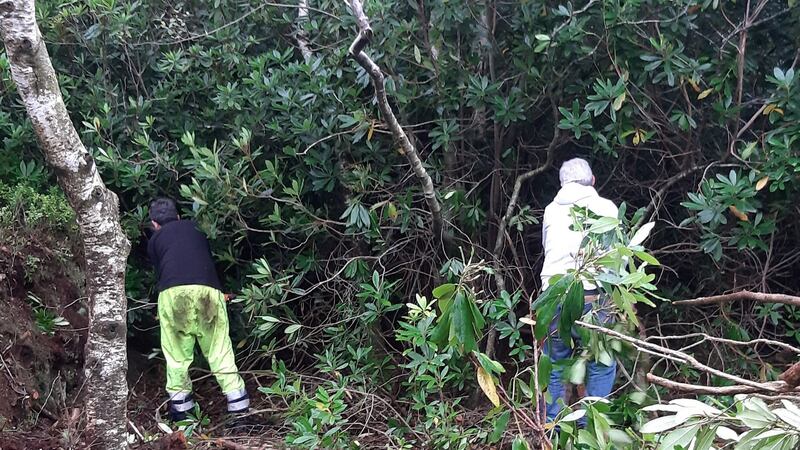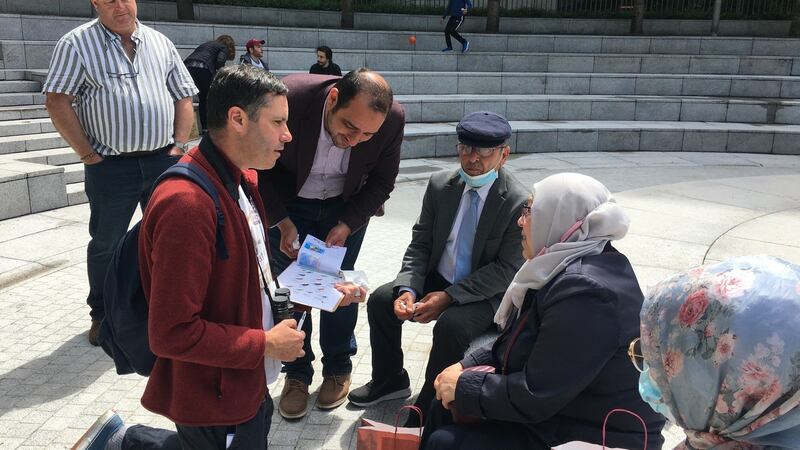Passing two direct provision centres on his way to work each day gave Lorcan Scott an idea. “At the time I was involved in some conservation projects where people were volunteering to go to bogs to clear them of rhododendron,” says Scott, who is wildlife officer with the Heritage Council.
The projects, allied to his daily commute, planted the seed of a question: “Would some of the people living in direct provision like to join in?”
“The idea was to show them what sort of wildlife Irish people hold dear and give some people some kind of work experience that might be of value to them,” he explains.
One of the conservation projects he was involved in at the time was at Abbeyleix Bog, where invasive rhododendrons were proliferating, to the detriment of wildflowers. “Very little grows under rhododendron, just leaf litter,” says Scott.
Groups of volunteers often carry out this kind of conservation work. For the local community of Abbeyleix, the local bog is a valued amenity. As well as helping to clear the unwanted scrub, they wanted to lay boardwalks and create a walkway through it.

For Scott, asking people living in nearby direct provision centres if they would like to join in was about inclusivity. “Due to the nature of the whole direct provision system, we find it very hard to find ways to communicate with residents and invite them to engage with our programmes” says Scott.
“These are the new Irish. We’d like them to have an opportunity to engage with our natural heritage, and this was a way of reaching them,” he explains.
The work was obviously important for the conservation of the site, but so too was the social element. “There’s lots of cross-pollination when you’re out working on the bog. We had people out there sharing stories about their own landscapes and their knowledge of habitats such as wadis and deserts, while there we were, afloat with water,” he recalls.
Keen to build on the success of the Abbeyleix Bog initiative, he is currently in talks with staff at the National Botanic Gardens about further conservation projects. This might include valuable projects such as seed collection drives, which he hopes will involve residents of direct provision centres in other parts of the country.
“The idea is that it becomes an event where families can come out together and we will ensure the younger children are entertained while the adults are seed collecting,” he says.
One of the fringe benefits of such activities are the friendships that are forged. “All our volunteer groups are social – we chat as much as we work. There’s always a real meitheal atmosphere, which is a great way of bonding.”

Scott has also connected with Sanctuary in Nature & Heritage, a Dublin-based group that has developed similarly inclusive initiatives for migrants, refugees and asylum seekers, particularly those living in direct provision centres.
It was set up by author and academic Paddy Woodworth, who had begun attending Places of Sanctuary meetings in response to the war in Syria, and the needs of those fleeing it.
Places of Sanctuary is a network of groups in towns, cities and local communities that share the objectives of promoting a culture of welcome and inclusiveness.
“We already had Cities of Sanctuary and Universities of Sanctuary. I had this idea, why not Sanctuary in Nature?” explains Woodworth.
“The mental and physical health benefits of spending time in nature are understood, and all these people are cooped up in direct provision. Maybe people would like to go on a nature walk? It was as naïve as that.”
Woodworth started by offering a local nature walk to residents of the direct provision centre at Mosney. Over time, the numbers attending his walks grew and more excursions followed, to places such as Bull Island and the estuary at Rogerstown.
Woodworth asked Dublin-based Syrian architect Muhammad Achour, who already knew many of the Syrians staying at Mosney, to become his partner on the project, changing its name to Sanctuary in Nature & Heritage in deference to Achour’s love of buildings.
Achour’s interests led to the inclusion of new day-trip destinations, such as Castletown in Kildare and Ardgillan Castle in Balbriggan, which included both house tours and nature walks. Eating together is a huge part of the social aspect of each outing. Wherever they go, meals are provided for the group and shared together.
Similarities in nature
When it comes to heritage, whether natural or built, it’s the little things that can remind people of home. Achour loves the columns outside Dublin’s GPO for example, because they remind him of the Roman and Byzantine architecture of his native Aleppo, as well as of the ancient Syrian city of Palmyra.
Similarities in nature can help to bridge great distances too. Swifts are of particular interest to him. “They migrate. I used to watch them in Syria too,” he says.
Birds hold even more fascination for his compatriot Michael*, who lives with his family in the direct provision centre in Mosney. He has been on two trips with Sanctuary in Nature & Heritage since coming to Ireland. “I had no car, no driving lessons, so I liked to see the nature and the heritage. Before I came to Ireland I tried to read up on it,” he explains.
Back home in Homs he had kept canaries. “The first journey we went on with Sanctuary in Nature & Heritage was to a nature park for birds, with a lake and a small room with a telescope, where an expert explained the birds, and I spoke about what I have in Syria,” he adds.

For all his family, the opportunity to meet people from other direct provision centres was welcome.
“A bus with 40 or 50 people comes to my camp, from more than one camp, so more nationalities – from Asia, from Europe – we go together. Sometimes we see the same people again, so it’s nice we have new friends.”
Els*, a mother of three from Albania, lived in the direct provision centre in Mosney for five years, before moving recently into the centre of a nearby city. She too appreciated the trips.
“The visits were good, my kids enjoyed it, especially my daughter, who is now eight and is so interested in birds and animals and nature. Paddy explained about all the flowers and the birds, so she was very excited about it,” she says.
But Els enjoyed them for herself too. “When you are living in direct provision, it is very difficult to make a social life. It is so isolated, your life is in limbo,” she explains.
“Even saying you live in Mosney isn’t nice. People think, oh you are one of those people. I used to tell people if they asked that I live in Julianstown. It was nice to be out on a trip and not have to be pretending you are someone you are not.”
A national model
Paddy Woodworth credits the Heritage Council, as well as the Office of Public Works, Fingal County Council, BirdWatch Ireland and Dublin City Council, with being enormously supportive of Sanctuary in Nature & Heritage. Lorcan Scott attended the group’s most recent outing, to Christ Church Cathedral in Dublin, as an observer.
“Our dream is to extend this model nationwide,” says Woodworth, who is keen to help others who would like to set up similar initiatives.
Scott feels similarly about volunteer conservation projects. “Hopefully other organisations will pick up the mantle too, so that there is more of this happening around the country,” says Scott. “That’s the goal.”
* Not their real names










